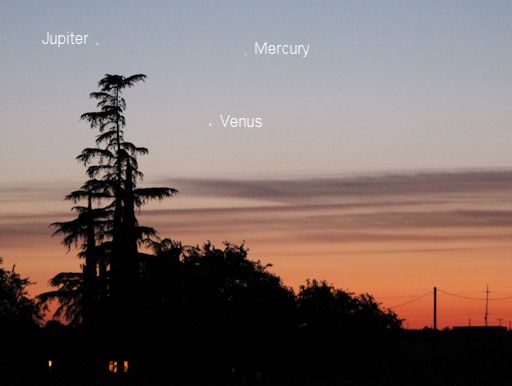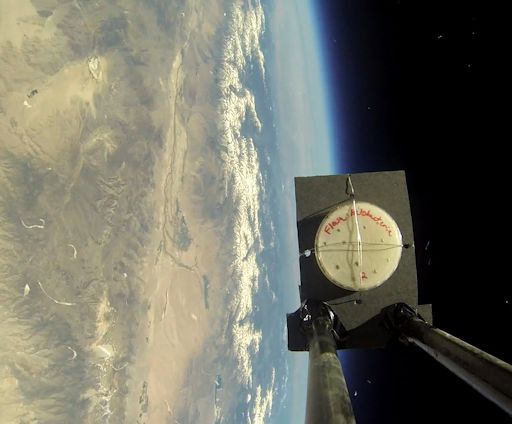When is the best time to see auroras? Where is the best place to go? And how do you photograph them? These questions and more are answered in a new book, Northern Lights - a Guide, by Pal Brekke & Fredrik Broms. | | |
SOLAR WIND STORM: Solar wind is blowing around Earth faster than 600 km/s (1.3 million mph) as our planet moves through the wake of a CME that struck on May 24th. This is causing geomagnetic unrest around the poles. Aurora sightings have been few, however, because of the competing glare of the full Moon. Aurora alerts: text, voice.
SUNSET PLANET SHOW: When the sun goes down tonight, step outside and look west. Venus, Jupiter and Mercury have converged to form a bright triangle in the sunset sky. Richard Sears sends this picture from Atwater, California:

"I took the picture on May 25th," says Sears. "What a way to end the day!"
Tonight will be even better. On Sunday, May 26th, the planets fit within a tightening circle less than 3o wide. There won't be another triple conjunction like this until October 2015, so don't miss it! NASA: video, full story.
Realtime Planet Photo Gallery
BACTERIA FLY INTO RADIATION STORM: Three days ago, high school students in Bishop, California, using a suborbital helium balloon launched a petri dish full of extreme-loving halobacteria into the strongest radiation storm of the year. They wanted to know how the extremophiles would fare when peppered with protons at the edge of space. Here is a picture of the sample 108,000 feet above Earth's surface:

The radiation storm was sparked by an M5-class solar flare on May 22nd. Students launched their microbes in the immediate aftermath of the flare when the highest energy protons (E > 100 MeV) were peaking in intensity. In addition to solar protons, the bacteria experienced air pressures only 1% that of sea level on the Earth below, temperatures as low as -65 C, and 70 mph winds. A student recovery team collected the payload from a remote desert in Nevada on May 23rd. Now they are culturing the bacteria to see if they survived.
The students, who call themselves Earth to Sky Calculus, have been launching research balloons for more than two years. Their projects include studies of high-altitude biology, measurements of the effects of solar flares on the ozone layer, and stratospheric photography of meteor showers.
How do they afford all this? To fund their activities, they have started a business called "Edge of Space Advertising." For a fee, they'll fly your banner, card, cow, running shoes, president or other object to the edge of space and send you the video. Contact Earth to Sky Calculus mentor Dr. Tony Phillips for details.
Realtime Space Weather Photo Gallery
Realtime Aurora Photo Gallery
Realtime Comet Photo Gallery
Realtime Noctilucent Cloud Photo Gallery
[previous years: 2003, 2004, 2005, 2006, 2007, 2008, 2009, 2011]

